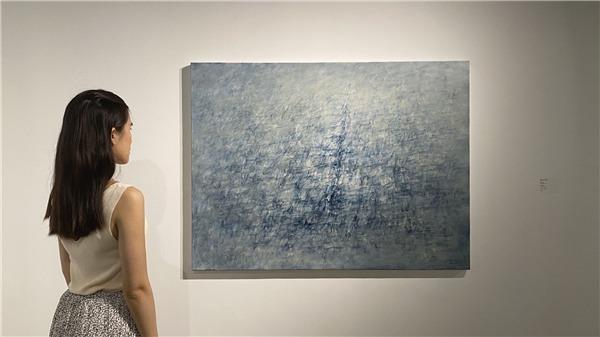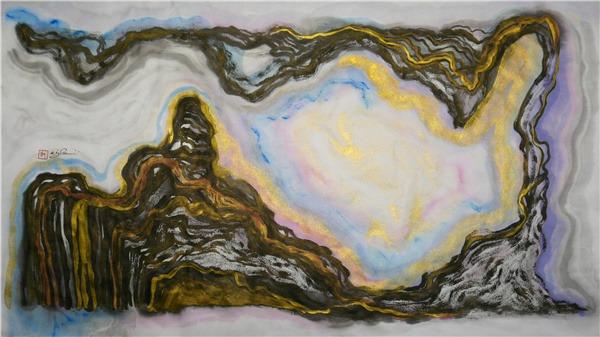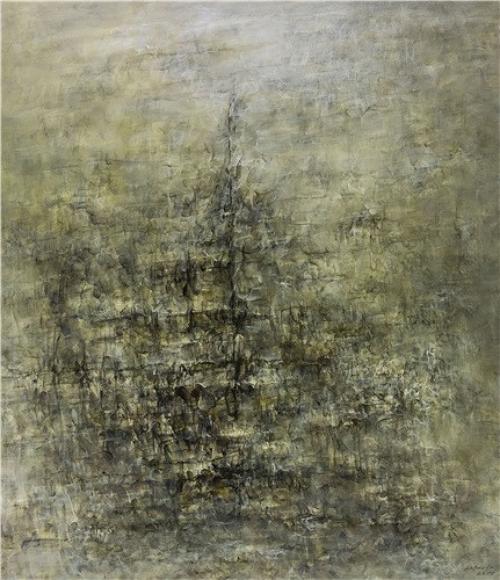 A visitor admires the painting Pervasion No 24 by Liu Guofu at the 3812 Gallery in Hong Kong. (PHOTO PROVIDED TO CHINA DAILY)
A visitor admires the painting Pervasion No 24 by Liu Guofu at the 3812 Gallery in Hong Kong. (PHOTO PROVIDED TO CHINA DAILY)
Museums and art galleries had to turn to their digital platforms with many introducing online exhibitions and virtual gallery spaces, as the novel coronavirus pandemic shuttered businesses.
The art world relies heavily on personal connections with clients, many of whom would want to view and scrutinize works of art, some costing thousands or even millions of dollars, in person.
Digital engagement is already here, ... All galleries are now online, art fairs have also gone online, you can’t really escape the online trend.
Calvin Hui, Chinese ink art expert and cofounder of the 3812 Gallery in Hong Kong and in London
The industry is socially driven by fairs, events, networks and gallery openings throughout the year, which gives opportunities for collectors and museum curators to purchase art as well as meet with artists, colleagues and art enthusiasts around the world.
Physical spaces haven't been possible over the months of the coronavirus pandemic and online digital has become a vital tool for the industry.
Art galleries had to explore alternatives to keep their businesses going as well as keep clients interested in what they have to offer at a click of a button.
Digital platforms have opened up a world of virtual reality exhibits, livestreaming services featuring interviews with artists, social media interaction as well as online viewing rooms, forums and panels.
"Digital is a trend that's not only for the art market, it is now part of our life and we now have to engage with digital trends," said Calvin Hui, Chinese ink art expert and co-founder of the 3812 Gallery in Hong Kong and in London.
"We would like our teams to move forward with the digital development of our gallery, in terms of website, social media and also the way to engage with collectors as well which is quite important," Hui said.
ALSO READ: Artist shows garbage is not rubbish
Hui believes the art market's relationship with digital technology goes "hand-in-hand" and the pandemic has created a moment that has pushed everyone to maximize their online presence.
Hui wants to create an art and digital space which can make the viewing experience "more vibrant and multidimensional" and that is why he is "keen to explore how to make use of digital devices and social media".
Before the novel coronavirus hit worldwide, 3812 Gallery was already planning on renewing its website and building online viewing rooms, add e-commerce functions and create new initiatives through digital engagement.
For his Gallery, Hui has embraced technology and art, a move that he said is unavoidable.
Hui is behind Ink Now, an art fair which is dedicated to contemporary ink art. He's also introduced artists in the "Tech Ink" era such as Victor Wong who uses artificial intelligence to help create ink artwork.
"Following on from contemporary art, we are now moving to technology and art, it's seems as natural progression," Hui said. "I launched 'Tech Ink' with artificial intelligence ink artists like Victor Wong and his AI Gemini, and I found this so meaningful and inspiring."
 The Fauvist Dreams of Gemini 05 by Victor Wong. (PHOTO PROVIDED TO CHINA DAILY)
The Fauvist Dreams of Gemini 05 by Victor Wong. (PHOTO PROVIDED TO CHINA DAILY)
Exploring the relationship between art and technology is almost "revolutionary and also groundbreaking", Hui said, adding "Art should be in the front line in bringing innovation, creativity and to educated and inspire people".
"3812 Gallery specializes in contemporary Chinese ink and when we talk about ink development, you find that technology has become so vital because this is allowing us to redefine the meaning of the old Asian traditional art medium and give it new meaning and new interpretation through technology," Hui said.
As artists move into digital, Hui expressed excitement in seeing how technology will change art and define cultural identity.
"Digital engagement is already here, especially in the last six months and even more so these past three months. All galleries are now online, art fairs have also gone online, you can't really escape the online trend," Hui said.
"But the challenge now is, how do we present ourselves. At every gallery, artists can express their creativity and collectors can go online as well. There is almost an overflow of information and visuals in the digital space."
With this in mind, Hui said they need to take note on how to present content and engage with collectors.
The pandemic has also forced other galleries to accelerate their online presence and at the same time it has given them the opportunity to launch newer and improved sites.
Stephen Ongpin, owner of the Stephen Ongpin Fine Art in London, was already in the process of overhauling their website and online viewing rooms before the virus hit.
"Our old website was looking a bit dated, so we decided in January we wanted to update it to have a lot more features and make it a bit more user friendly," he said.
While gallery owners have been saying that online is no substitute for seeing works in person, the lockdown has encouraged them to find new ways to make online businesses work.
"We make sure that the images in our catalogs and the images on our website are extremely accurate in terms of how they reproduce the work of art," Ongpin said.
"We wanted to allow someone on a computer to really zoom into an image and see the detail and see the quality of the craftsmanship and see the pen strokes or brush strokes."
The gallery has also framed the works of art and mounted them on digital walls to give clients "a sense of how it looks as a complete package" on the website, something that wasn't done previously.
They have also produced short videos explaining individual works of art and launched a virtual gallery space featuring new exhibitions to give a sense of what it is to be in the gallery and see the exhibition.
"You can stand in the middle of the gallery and rotate around the gallery, focus on individual works and also zoom into them and you can also view the full information sheet," Ongpin said.
Taking a similar strategy is Osbourne Samuel in London, who specializes in modern and contemporary works of British art.
They have created what they say is a more "dynamic" and interesting way to target individual clients.
 Pervasion No 5 by Liu Guofu. (PHOTO PROVIDED TO CHINA DAILY)
Pervasion No 5 by Liu Guofu. (PHOTO PROVIDED TO CHINA DAILY)
The London gallery launched a series of videos with artists in their studios discussing their work as well as also using virtual reality technology which they hope to develop further where users can engage directly with artists and staff at the gallery.
Their aim is so "people get a better feeling of being part of the action than being distanced from it".
"It's the new world, we're all having to adapt to that, but what is important is that this in itself is not going to replace the face-to-face traditional way of running a business like mine," said Peter Osborne, co-owner of Osborne Samuel. "We have all raised our game in the area and there are people out there who will buy from us on their phones and on their tablets for things they never physically seen."
Annual art fairs have also taken the step in launching online viewing rooms as a response to the current situation.
We’re excited to try new ways of reaching out to our clients and showing a range of what’s to offer, but it’s no substitute for standing in front of a client.
Stephen Ongpin, owner of the Stephen Ongpin Fine Art in London and chairman of London Art Week
Ongpin, who is also chairman of London Art Week which takes place July 3-10, said the decision to go ahead with an online fair was to create a new space for dealers to work together.
"We have completely revamped the London Art Week website so that the exhibitors can upload between eight and 25 works of art; before it was only around three to four images each," he said.
Some 53 exhibitors, with some newcomers, will be taking part in the event including those from Germany, France, Italy and the United States as well as those in the United Kingdom.
Ongpin said going online has allowed a much broader group of galleries to take part, but also maintains the collegiate nature of the event.
The fair isn't meant to "replace the sheer pleasure of looking at works of art and being in a gallery and talking to dealer in front of object, but it's something we firmly believe will be a very appealing and innovating way of experiencing what galleries through London, Europe and America have to offer at this time," he said, adding that the camaraderie will be something missing this year.
Paul Gladston, professor of contemporary art at the University of New South Wales in Sydney, said, the role of virtual viewing and experience of art has been greatly enhanced and will remain so into the future.
"Rather than being a detached way of showing art, the virtual as a primary mode of artistic expression will develop further," Gladston said.
"This means that the virtual will become more an embodied site of aesthetic experience instead of being a secondary means of representation. We have already been traveling in that direction. The COVID-19 pandemic will almost certainly accelerate things. Conventional online representation will respond by also becoming more sophisticated; for example, like the online presence of the Shibunkaku Gallery in Kyoto."
While some younger people who grew up with the internet may be more comfortable to spend a lot online for things they have never seen in person, galleries say the idea of entirely replacing physical events and galleries with online ones won't be a threat to the more traditional model of business.
 Metaphor Vision 171002 by Wang Huangsheng. (PHOTO PROVIDED TO CHINA DAILY)
Metaphor Vision 171002 by Wang Huangsheng. (PHOTO PROVIDED TO CHINA DAILY)
Hui of 3812 Gallery said combining the physical and virtual will bring something interesting to the art market, but physical contact is irreplaceable and there is still room for the traditional.
"This is a unique industry," he said. "Art appreciation, purchasing art and other traditional elements such as face-to-face contact is still the most important factor for us to develop the art market."
Hui added: "I also remind my team that we should remember to share our values. So, no matter how you want to be innovative, how you want to be different when you present yourself online, don't forget who you are and your core values, your vision and mission."
Osborne said: "One of the reason people buy art and other luxury goods is because of the interaction and added value and the relationship with the seller that exists when you come into an art gallery, fair, or showroom."
READ MORE: Portraits of a pandemic
He believes people will reengage physically with works of art which can't be totally replaced by an online experience.
"There are those who like attending art fairs and connecting with the art works," Osborne said. "It's not just the value but the added value and this is important business."
With lockdown gradually easing in the UK, galleries are slowly opening their doors.
However, appointment only visits and social distancing will remain for now, a new normal which the industry will have to adjust to.
"We're excited to try new ways of reaching out to our clients and showing a range of what's to offer, but it's no substitute for standing in front of a client," Ongpin said noting that the experience of the pandemic has "changed the art world in a way".


